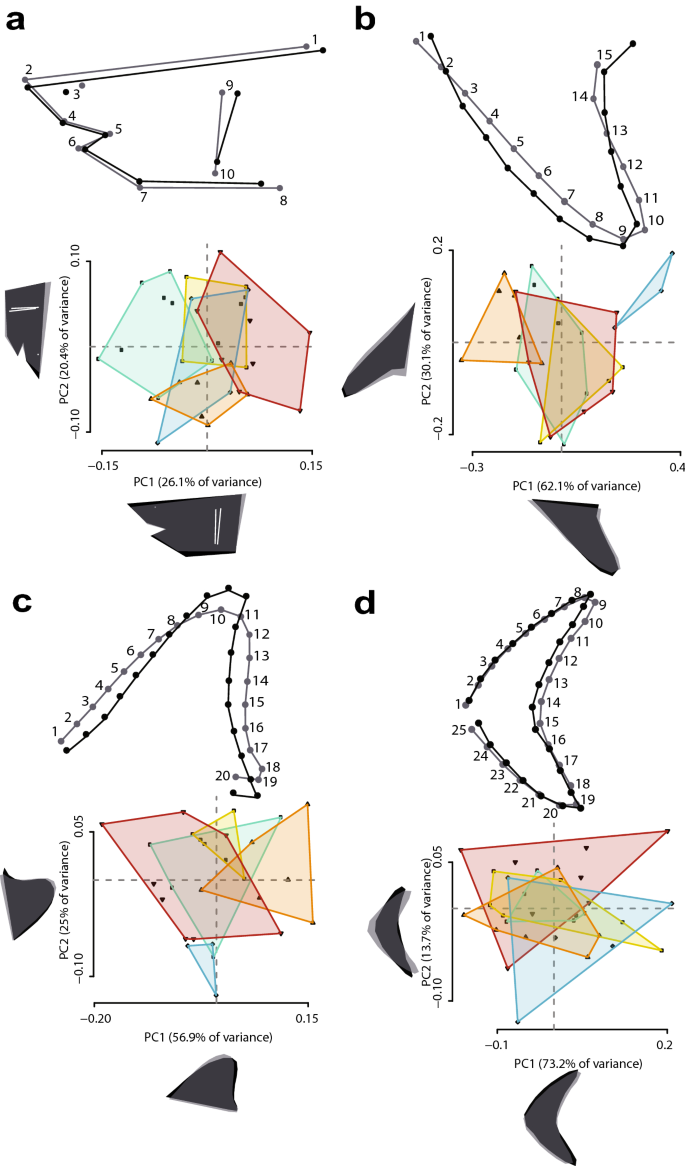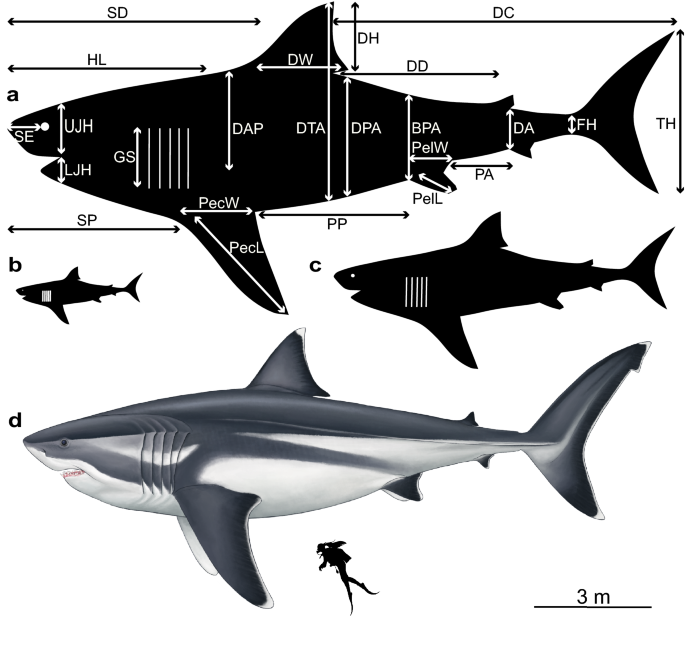- 1.
Reynolds, P. S. How big is a giant? The importance of method in estimating body size of extinct mammals. J. Mammal. 83, 321–332 (2002).
Google Scholar
- 2.
Pyenson, N. D. & Sponberg, S. N. Reconstructing body size in extinct crown Cetacea (Neoceti) using allometry, phylogenetic methods and tests from the fossil record. J. Mammal. Evol. 18, 269–288 (2011).
Google Scholar
- 3.
Gottfried, M. D., Compagno, L. J. V. & Bowman, S. C. Size and skeletal anatomy of the giant “megatooth” shark Carcharodon megalodon. In Great White Sharks: The Biology of Carcharodon carcharias, Ch 7 (eds Klimley, A. P. & Ainley, D. G.) (Academic Press, San Diego, 1996).
Google Scholar
- 4.
Pimiento, C. & Balk, M. A. Body-size trends of the extinct giant shark Carcharocles megalodon: A deep-time perspective on marine apex predators. Paleobiology 41, 479–490 (2015).
PubMed PubMed Central Google Scholar
- 5.
Shimada, K. The size of the megatooth shark, Otodus megalodon (Lamniformes: Otodontidae), revisited. Hist. Biol. 20, 1–8 (2019).
Google Scholar
- 6.
Agassiz, L. Recherches sur les Poissons Fossiles (Imprimerie de Petitpierre, Neuchatel, 1833).
Google Scholar
- 7.
Applegate, S. P. & Espinosa-Arrubarrena, L. The fossil history of Carcharodon and its possible ancestor, Cretolamnia: A study in tooth identification. In Great White Sharks: The Biology of Carcharodon carcharias, Ch 4 (eds Klimley, A. P. & Ainley, D. G.) (Academic Press, San Diego, 1996).
Google Scholar
- 8.
Purdy, R. W. Paleoecology of fossil white sharks. In Great White Sharks: The Biology of Carcharodon carcharias, Ch 8 (eds Klimley, A. P. & Ainley, D. G.) (Academic Press, San Diego, 1996).
Google Scholar
- 9.
Pimiento, C., Ehret, D. J., MacFadden, B. J. & Hubbell, G. Ancient nursery area for the extinct giant shark Megalodon from the Miocene of Panama. PLoS One 5, e10552 (2010).
ADS PubMed PubMed Central Google Scholar
- 10.
Pimiento, C. et al. Geographical distribution patterns of Carcharocles megalodon over time reveal clues about extinction mechanisms. J. Biogeogr. 43, 1645–1655 (2016).
Google Scholar
- 11.
Shimada, K. The relationship between the tooth size and total body length in the white shark. J. Fossil Res. 35, 28–33 (2003).
Google Scholar
- 12.
Pimiento, C. et al. Sharks and rays (Chondrichthyes, Elasmobranchii) from the late Miocene Gatun formation of Panama. J. Paleontol. 87, 755–774 (2013).
Google Scholar
- 13.
Reolid, M. & Molina, J. M. Record of Carcharocles megalodon in the Eastern Guadalquivir Basin (Upper Miocene, South Spain). Estud. Geol. 71, e032 (2015).
Google Scholar
- 14.
Razak, H. & Kocsis, L. Late Miocene Otodus (Megaselachus) megalodon from Brunei Darussalam: Body length estimation and habitat reconstruction. Neues Jahrb. Geol. Paläontol. Abh. 288, 299–306 (2018).
Google Scholar
- 15.
Nyberg, K. G., Ciampaglio, C. N. & Wray, G. A. Tracing the ancestry of the great white shark, Carcharodon carcharias, using morphometric analyses of fossil teeth. J. Vertebr. Paleontol. 26, 806–814 (2006).
Google Scholar
- 16.
de Muizon, C. & Devries, T. J. Geology and paleontology of late Cenozoic marine deposits in the Sacaco area (Peru). Geol. Rundsch. 74, 547–563 (1985).
ADS Google Scholar
- 17.
Ehret, D. J., Hubbell, G. & MacFadden, B. J. Exceptional preservation of the white shark Carcharodon (Lamniformes, Lamnidae) from the early Pliocene of Peru. J. Vertebr. Paleontol. 29, 1–13 (2009).
Google Scholar
- 18.
Ehret, D. J. et al. Origin of the white shark Carcharodon (Lamniformes: Lamnidae) based on recalibration of the Upper Neogene Pisco Formation of Peru. Palaeontology 55, 1139–1153 (2012).
Google Scholar
- 19.
Cione, A. L., Cabrera, D. A. & Barla, M. J. Oldest record of the great white shark (Lamnidae, Carcharodon; Miocene) in the Southern Atlantic. Geobios 45, 167–172 (2012).
Google Scholar
- 20.
Ward, D. J. & Bonavia, C. Additions to, and a review of, the Miocene shark and ray fauna of Malta. Cent. Mediter. Nat. 3, 131–146 (2001).
Google Scholar
- 21.
Cappetta, H. Chondrichthyes–Mesozoic and Cenozoic Elasmobranchii: Teeth (Verlag F, Pfeil, 2012).
Google Scholar
- 22.
Shimada, K., Chandler, R. E., Lam, O. L. T., Tanaka, T. & Ward, D. J. A new elusive otodontid shark (Lamniformes: Otodontidae) from the lower Miocene, and comments on the taxonomy of otodontid genera, including the ‘megatoothed’ clade. Hist. Biol. 29, 704–714 (2017).
Google Scholar
- 23.
Ferrón, H. G., Martínez-Pérez, C. & Botella, H. The evolution of gigantism in active marine predators. Hist. Biol. 30, 712–716 (2017).
Google Scholar
- 24.
Ferrón, H. G. Regional endothermy as a trigger for gigantism in some extinct macropredatory sharks. PLoS One 12, e0185185 (2017).
PubMed PubMed Central Google Scholar
- 25.
Pimiento, C., Cantalapiedra, J. L., Shimada, K., Field, D. J. & Smaers, J. B. Evolutionary pathways toward gigantism in sharks and rays. Evolution 73, 588–599 (2019).
PubMed Google Scholar
- 26.
Irschick, D. J. & Hammerschlag, N. Morphological scaling of body form in four shark species differing in ecology and life history. Biol. J. Linn. Soc. Lond. 114, 126–135 (2014).
Google Scholar
- 27.
Irschick, D. J. et al. A comparative morphological analysis of body and fin shape for eight shark species. Biol. J. Linn. Soc. Lond. 122, 589–604 (2017).
Google Scholar
- 28.
Mollet, H. F. & Cailliet, G. M. Using allometry to predict body mass from the linear measurements of the white shark. In Great white Sharks: The Biology of Carcharodon carcharias, Ch 9 (eds Klimley, A. P. & Ainley, D. G.) (Academic Press, San Diego, 1996).
Google Scholar
- 29.
Witmer, L. M. The extant phylogenetic bracket and the importance of reconstructing soft tissues in fossils. In Functional Morphology in Vertebrate Paleontology, Ch 2 (ed. Thomason, J. J.) (Cambridge University Press, Cambridge, 1995).
Google Scholar
- 30.
Compagno, L. J. V. Sharks of the World: An Annotated and Illustrated Catalogue of Shark Species Known to Date. FAO Species Catalogue for Fishery Purposes 2 269 (Food and Agriculture Organization, Rome, 2001).
Google Scholar
- 31.
Lingham-Soliar, T. Caudal fin allometry in the white shark Carcharodon carcharias: Implications for locomotory performance and ecology. Naturwissenschaften 92, 231–236 (2005).
ADS CAS PubMed Google Scholar
- 32.
Kim, S. H., Shimada, K. & Rigsby, C. K. Anatomy and evolution of heterocercal tail in lamniform sharks. Anat. Rec. 296, 433–442 (2013).
Google Scholar
- 33.
Bruce, B. D., Stevens, J. D. & Malcolm, H. Movements and swimming behaviour of white sharks (Carcharodon carcharias) in Australian waters. Mar. Biol. 150, 161–172 (2006).
Google Scholar
- 34.
Watanabe, Y. Y., Payne, N. L., Semmens, J. M., Fox, A. & Huveneers, C. Swimming strategies and energetics of endothermic white sharks during foraging. J. Exp. Biol. 222, 185603 (2019).
Google Scholar
- 35.
Gutarra, S. et al. Effects of body plan evolution on the hydrodynamic drag and energy requirements of swimming in ichthyosaurs. Proc. R. Soc. B. 286, 20182786 (2019).
PubMed Google Scholar
- 36.
Fallows, C., Gallagher, A. J. & Hammerschlag, N. White sharks (Carcharodon carcharias) scavenging on whales and its potential role in further shaping the ecology of an apex predator. PLoS One 8, e60797 (2013).
ADS CAS PubMed PubMed Central Google Scholar
- 37.
Kallal, R. J., Godfrey, S. J. & Ortner, D. J. Bone reactions on a Pliocene cetacean rib indicate short-term survival of predation event. Int. J. Osteoarchaeol. 22, 253–260 (2010).
Google Scholar
- 38.
Estrada, J. A., Rice, A. N., Natanson, L. J. & Skomal, G. B. Use of isotopic analysis of vertebrae in reconstructing ontogenetic feeding ecology in white sharks. Ecology 87, 829–834 (2006).
PubMed Google Scholar
- 39.
Collareta, A. et al. Did the giant extinct shark Carcharocles megalodon target small prey? Bite marks on marine mammal remains from the late Miocene of Peru. Palaeogeogr. Palaeoclimatol. Palaeoecol. 469, 84–91 (2017).
Google Scholar
- 40.
Wroe, S. et al. Three-dimensional computer analysis of white shark jaw mechanics: How hard can a great white bite?. J. Zool. 276, 336–342 (2008).
Google Scholar
- 41.
Rowland, H. M. From Abbott Thayer to the present day: What have we learned about the function of countershading?. Philos. Trans. R. Soc. B. 364, 519–527 (2008).
Google Scholar
- 42.
Ruxton, G. D., Speed, M. P. & Kelly, D. J. What, if anything, is the adaptive function of countershading?. Anim. Behav. 68, 445–451 (2004).
Google Scholar
- 43.
Perez, V. J., Godfrey, S. J., Kent, B. W., Weems, R. E. & Nance, J. R. The transition between Carcharocles chubutensis and Carcharocles megalodon (Otodontidae, Chondrichthyes): Lateral cusplet loss through time. J. Vertebr. Paleontol. 38, e1546732 (2019).
Google Scholar
- 44.
Froese, R & Pauly, D. FishBase, www.fishbase.org (2019)
- 45.
GBIF.org. GBIF Home Page. www.gbif.org. Accessed June (2019).
- 46.
Pollerspöck, J. & Straube, N. Bibliography Database | Shark-References. www.shark-references.com (2015)
- 47.
Reiss, K. L. & Bonnan, M. F. Ontogenetic scaling of caudal fin shape in Squalus acanthias (Chondrichthyes, Elasmobranchii): A geometric morphometric analysis with implications for caudal fin functional morphology. Anat. Rec. 293, 1184–1191 (2010).
Google Scholar
- 48.
Ginter, C. C., DeWitt, T. J., Fish, F. E. & Marshall, C. D. Fused traditional and geometric morphometrics demonstrate pinniped whisker diversity. PLoS One 7, e34481 (2012).
ADS CAS PubMed PubMed Central Google Scholar
- 49.
Park, P. J., Aguirre, W. E., Spikes, D. A. & Miyazaki, J. M. Landmark-based geometric morphometrics: What fish shapes can tell us about fish evolution. Proc. Assoc. Biol. Lab. Educ. 34, 361–371 (2013).
CAS Google Scholar
- 50.
Ponton, D., Carassou, L., Raillard, S. & Borsa, P. Geometric morphometrics as a tool for identifying emperor fish (Lethrinidae) larvae and juveniles. J. Fish Biol. 83, 14–27 (2013).
CAS PubMed Google Scholar
- 51.
Hammerschlag, N. & Sulikowski, J. Killing for conservation: The need for alternatives to lethal sampling of apex predatory sharks. Endanger. Species Res. 14, 135–140 (2011).
Google Scholar
- 52.
ImageMagick Studio, L.L.C. ImageMagick: Convert, Edit, and Compose Images. www.ImageMagick.org (2014).
- 53.
Abràmoff, M. D., Magalhães, P. J. & Ram, S. J. Image processing with ImageJ. Biophoton. Int. 11, 36–42 (2004).
Google Scholar
- 54.
R Development Core Team. R: A Language and Environment for Statistical Computing, 3.4.2 Edition (R Foundation for Statistical Computing, Vienna, 2017).
Google Scholar
- 55.
Mangiafico, S. & Mangiafico, M. S. Package ‘rcompanion’. Cran Repos. 20, 1–71 (2017).
Google Scholar
- 56.
Ferrón, H. G., Martínez-Pérez, C. & Botella, H. Ecomorphological inferences in early vertebrates: Reconstructing Dunkleosteus terrelli (Arthrodira, Placodermi) caudal fin from palaeoecological data. PeerJ 5, e4081 (2017).
PubMed PubMed Central Google Scholar
- 57.
Rohlf, F.J. TPSDig2: A Program for Landmark Development and Analysis. www.life.bio.sunysb.edu/morph (2001).
- 58.
Klingenberg, C. P. MorphoJ: An integrated software package for geometric morphometrics. Mol. Ecol. Resour. 11, 353–357 (2010).
PubMed Google Scholar
- 59.
Chapman, R. E. Conventional procrustes approaches. In Proceedings of the Michigan morphometrics workshop (Vol. 2) (ed. Arbor, A.) Ch. 12 (University of Michigan Museum of Zoology, 1990).
- 60.
Klingenberg, C. P. & McIntyre, G. S. Geometric morphometrics of developmental instability: Analyzing patterns of fluctuating asymmetry with Procrustes methods. Evolution 52, 1363–1375 (1998).
PubMed Google Scholar
- 61.
Sheets, H. D. IMP: CoordGen8–Coordinate Generation Utility. www.canisius.edu/~sheets/CoordGenManual.htm (1998).



